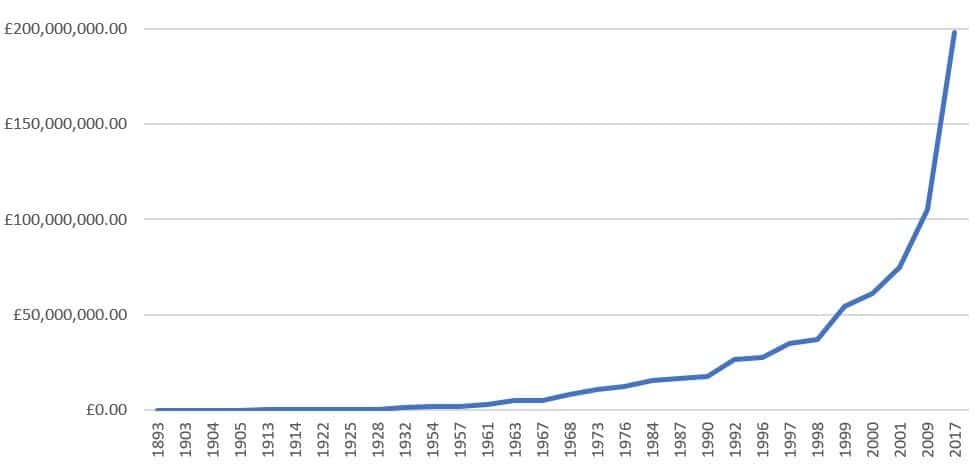Sport
The madness of football transfer fees
A few weeks ago, Aaron Wan-Bissaka agreed a deal that took him from Crystal Palace to Manchester United for a fee that could reach £50 million. The price tag makes him the the joint most expensive Englishman of all time, the second most expensive full back of all time, the fifth most expensive defender of all time and the 42nd most expensive football player of all time. For Palace it’s an incredible return on a 21-year-old academy product with just 42 career appearances, equating to just under £1.2 million for every game played so far.
Yet such lunacy has become commonplace in football, with the game now existing almost entirely within its own bubble. Fees that would have once caused eyes to water now hardly merit the raising of an eyebrow. So vast are the sums that currency almost possesses a different value within football than in the real world. Fans are becoming desensitized to the amounts quoted, demanding their clubs spend more and more without realising the true magnitude of the outlay. I’m a Crystal Palace fan and will admit to initially feeling disappointed that we didn’t receive more, before realising how insane that was.
Wan-Bissaka’s astronomical fee is far from an isolated case and is merely the latest example of a culture that will surely eventually cripple football, or at the very least cause such drastic economic ripples that rule changes will be mandatory. Below is a table that represents the history of the world record transfer fee, to illustrate football’s snowballing spending. The table has been adjusted for inflation, or the effect would be even more drastic.
With the record having been broken 46 times, the adjusted value of the first 41 on the list adds up to roughly the same as the most recent five. The spike is unlikely to level out any time soon, with Kylian Mbappe heavily rumoured to break the transfer record once again in the next 12 months by moving to Real Madrid for an estimated £250+ million. But what has stimulated the drastic rise in transfers fees and where will it end?
Much of the money arrives courtesy of TV rights deals, with the rise in Premier League TV packages taking a similar trajectory to the graph above. Since the league’s inception in 1992, the rights have been auctioned on nine occasions and whilst the original package was sold to Sky for £200 million, the 2016 – 2019 rights sold for an astonishing £5.1 billion, a 2550% increase.
Unlike that graph though, the rights didn’t continue to rise past that point. In fact in 2018, for the first time in Premier League history, the cost actually decreased from £5.1 billion to £4.4 billion, a 14% drop. Yet despite the decline in TV revenue, Premier League spending on transfers actually accelerated.
With the 20 clubs having spent a combined £825 million on players in 2017/18, £38 million higher than the year before, they grew again by a staggering £287 million to £1.1 billion in the 2018/19 season, surpassing the billion pound mark for the first time.
It doesn’t take a genius to realise that revenue cannot continue to drop, or even plateau, while spending continues to increase indefinitely, eventually something has to give. Obviously clubs aren’t entirely reliant on television money for their income. Lucrative sponsorship deals, merchandising, gate receipts and various other incomes all play a part but it is fair to say that television is the primary revenue source.
This may seem an extreme reaction to a player moving from a bitter Palace fan but Wan-Bissaka’s transfer is emblematic of an overall trend. Despite his obvious talent, he lacks many of the hallmarks of the typical marquee signing. He isn’t an attacking player and doesn’t currently possess the marketability or social media presence as the likes of Paul Pogba.
He also hasn’t yet won a full England cap or even been called up to a squad. Wan-Bissaka’s purchase is purely based on footballing potential, exactly the kind of player Manchester United should be recruiting, but whereas signing potential was once a cheap alternative to the Galactico culture, now even that costs the big bucks.
I also don’t believe that these transfers are always as beneficial to the selling club as it might seem. Yes, Crystal Palace now have a wedge in the bank but will now find a 15% premium on every player they try to sign this summer as a result. Clubs selling to Palace will hold all the cards, knowing they can afford to be held hostage. It is a situation that Watford’s business model cleverly combats, as they look to identify replacements before their stars leave.
The boom can’t go on forever but where it ends isn’t clear. Perhaps footballers will eventually reach their natural value ceiling, an admittedly unlikely outcome. Alternatively football could just implode under the weight of its own financial obligations as fans are priced out of the game and depart in droves. In all likelihood, though, there will eventually be an enforced overhaul of the entire transfer system when the fees simply get too absurd. In the meantime though, we’ll just have to sit back and watch.








